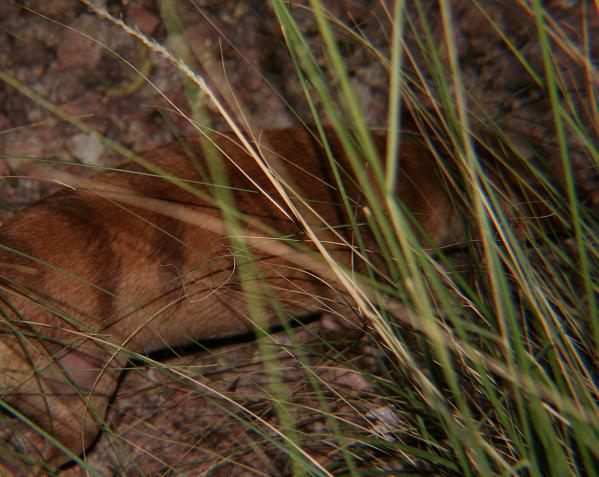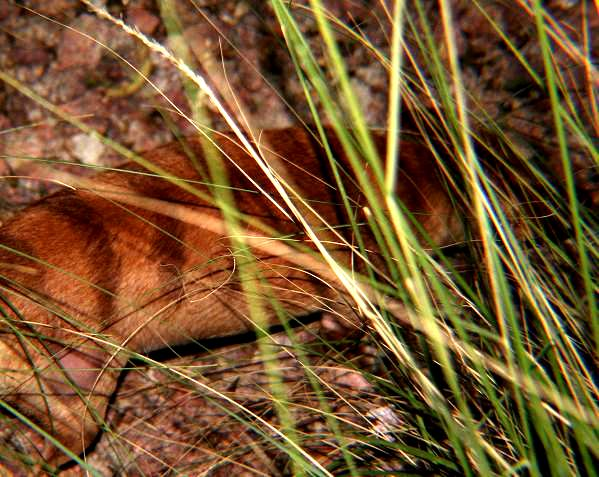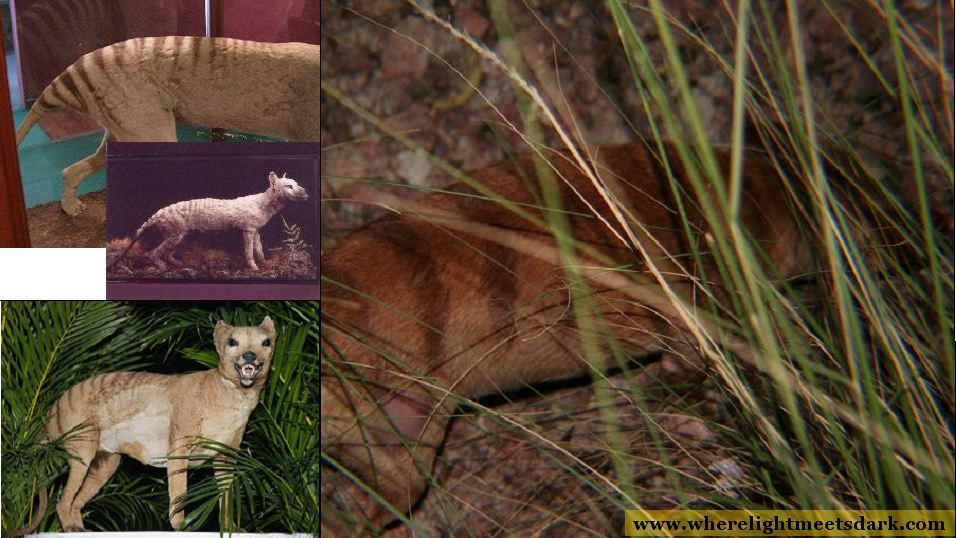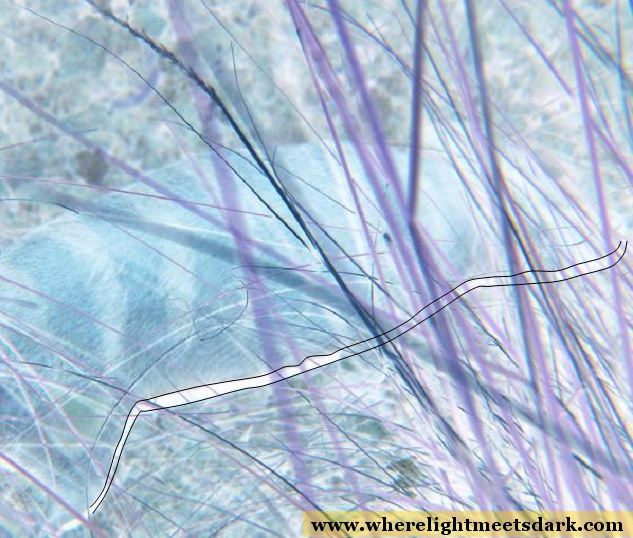Chaotika thylacine - second analysis
In October 2006, a person using the online name "Chaotika" published a photograph which was sent to her from Tasmania, of an animal resembling a thylacine.
My original analysis of the image examined a variety of explanations for the image, including an artificially coloured platypus or dog.
At the time I wrote that "very little useful information can be obtained from the image at this point" and that "I would be happy to continue the analysis with the additional and/or original images, and to discuss them with either the photographer or the publisher."
Chaotika did return my email some time ago to provide a little more background to the story. First, here is a recap of the original information presented with the image:
The backstory
Here is Chaotika's original post (with emoticons removed)
"A friend of mine went on vacation to Australia, and he e-mailed me this picture a week ago- he said he snapped a picture as soon as he saw the animal, and the flash made it run away.. He said it was small, like a puppy, and it ran akwardly towards a larger "striped German-shephard /Kangaroo thing", and they both disappeared into the brush.
He called it a "Striped Puppy Kangaroo Thing", and he sent it to me because I used to be a vet tech and can ID almost any animal, and am especially good with dog breeds. I think he may have seen 2 Thylacines, but it's not a good picture. He took one as they were running off, too, but you can't see anything in it except bushes and the night sky. When he showed me the picture, I told him I thought they may be Tassie Tigers, and that he should tell someone.I also told him to hold on to his pictures since in my research I read that sometimes when people report sightings park rangers confiscate their evidence. He wrote me the next day saying that everyone he talked to told him he didn't see a Tassie Tiger, and he said a policeman he mentioned it to threatened to take him in for pranking. When he told the cop it wasn't a prank, the cop told him "You didn't see anything, understood?"
I've known this boy forever, and he is always honest (brutally so, at times)
What do you think?
He finally ok'd me to share it, but he wants his identity to remain private. He was very offended by the people in Tasmania calling him a liar, and the cop shook him up pretty bad. He seems convinced that that cop will track him down, the poor guy.
Anywho, it'd be nice to find out what other people think of this...
I think it's damn convincing. Aside from the damn plant in the way, I'd say I'm convinced. The number of stripes is variable, from what I've read, and this is also a pup, as he said.. I can't find any info on patterns of pups- does anyone else have info?
If anyone is out there who maybe has equipment to maybe edit out the plants or something, that would be great
By the way- He said he was hiking near "Savage River" when he took this photo, and that it was not far from a wildlife preserve or park of some sort, yet he was also not far from all sorts of factories and mining operations...
If this truly is a Tassie, then that's also a horrible place for some polluting, disgusting mines." (Chaotika, 2006 A)
Further information from Chaotika
I contacted Chaotika soon after, and received a reply as follows:
"Hi there :)
No, I had no idea- everyone seemed to think it was fake, and it was not my photograph- I've never been to Tasmania, unfortunately :( I wish!!!
Anywho, I didn't take the picture, he did, and he sent me the one that I posted only. He told me he deleted what was on his camera afterwards, so the other picture is probably gone. I know he was worried about the cops and whatnot.
I did read your article, and while I do agree in reference to the stripes width and spacing, He said it was a small animal that passed in the brush by his feet when he took the picture, and judged it to be a juvenile. I've not yet seen what the striping on a young thylacine looks like- I've been searching for pictures of thyla-pups ever since.
I don't agree with the "Platypus" idea at all, however, for several reasons:
1) The animal doesn't carry itself low enough to the ground
2) Thew platypus has thick, waterproof fur, the animal in the photo appears to have a thinner, lighter coat
3) It is turning it's head: the "?beak" is a shadow
" (Chaotika, 2006 B)
Second thoughts on the Chaotika thylacine
I have to say that I agree with Chaotika's rejection of the platypus theory. The idea was first posed in the commentary at Cryptomundo and I feel I entertained that concept for far longer than warranted in the original analysis.
Nevertheless, what more can we say regarding this most captivating of thylacine images?
I have had a small number of professionals (from a variety of fields) contact me to suggest that in their opinion the animal is nothing more than a painted dog. Again, a number of correspondents observed that the stripe spacing in no way resembles any known image of a thylacine. Commentators in other forums have suggested that just because we have not yet seen such a striping pattern, that does not make it impossible. Others remarked that in some thylacine specimens, the striping was barely visible at all. Whether such observations were based on aging and faded museum specimens, or research of first hand accounts I cannot say.
Even Chaotika in her correspondence agrees that the stripe width and spacing are uncharacteristic for a thylacine. She suggests that perhaps its being a juvenile might explain the discrepancy. Indeed she is right to say that images of juveniles are hard to locate on the web, but the small number in Robert Paddle's book "The Last Tasmanian Tiger" (Paddle, 2000) and published elsewhere online (see Campbell, undated for an example), seem to indicate that juveniles retained the same appearance with regards to their striping pattern, into adulthood. In other words, the theory that a juvenile might exhibit a different pattern when it becomes an adult is unlikely.
Despite the opinions of others, and even though it even feels counter-intuitive even to me, I have to concede that the images I sourced in the original analysis (and shown again here) do in fact show thylacines with vaguely similar striping patterns. I know nothing of the history of these thylacine images, nor whether the stripes are the animals' originals, or latter applications to poor taxidermies. Again, I have to acknowledge the professional background of those people who corresponded to say that the Chaotika thylacine striping pattern does not in any way resemble any known thylacine pattern.
Missing a head. And a tail.
Several correspondents felt that the lack of obvious head or tail cried "foul" for this image. Chaotika's explanation is that the animal "is turning it's head", with the so-called "platypus" beak being a shadow - of the thylacine's head. This being the case implies the anterior (front) of the animal is at right in the image.
Despite numerous correspondents in other forums describing in textual detail how they could see the head in the Chaotika image, I have to confess I simply cannot make out any discernable head. Even if one were overlaid on the image I would be hesitant to accept the interpretation because clearly such an interpretation would be ambiguous to begin with.
If the animal is facing the other way (which is contrary to Chaotika's opinion), then the stripes above the forelimb (at left in the image) appear even more uncharacteristic for the species.
Skin patch
Many people across different discussion forums made remark about the pinkish patch of what appears to be skin on the right hindleg (at bottom left in the image). Most reasoned that this could not be a taxidermy because of the richness of colour on this patch. For many, this was proof positive that this in fact depicted a live thylacine. However being a live animal does not automatically equate to being a thylacine. In addition, variances in colouration are sure to result from any of the following: the camera brand, exposure settings, lighting conditions, the object (animal) itself, any (legitimate) file manipulation (possibly including simply saving the file to PC as this is a lossy JPEG format), the monitor brand you are using, monitor settings, your own lighting conditions and the condition of your eyes.
In other words, colour is never a reliable indicator, much less when computers are involved.
The backstory One feature of the story often commented on, is how outlandish it would seem that authority figures themselves - in this case the police - should threaten a thylacine witness.
Clearly I have no experience whatsoever with any official response from any Tasmanian authorities to a potential thylacine sighting, but such allegations in similar circumstances are not new. Buck and Joan Emberg, authors of the tasmanian-tiger.com website list numerous sightings implicating official authorities in conspiracy.
Their first sighting story alleges that a member of the Parks and Wildlife service said "Yes, it looks like you saw what you saw. Now, will you do us a favur and shut up about it? Don't tell anyone" (Emberg, undated A). In their eleventh sighting case the witness, who allegedly killed a thylacine in 1953 - just 17 years after official extinction - says of the Fauna Board representatives (one a police officer, the other from New South Wales) "The chap with all the say poked me in the chest very hard and told me (killing a thylacine) cold cost me £1000". According to the report, the witness "was told he could even be jailed for killing a thylacine." (Emberg, undated B)
The witness offers his own opinion on the reasons behind the aggression: ""They were putting pines in there and if a tiger was found they’d be worried they would be shut down" (Emberg, undated B). Although this north-eastern Tasmanian sighting differs from the western Chaotika thylacine in suggesting the forestry industry, rather than the mining industry may have been the cause for the pressure - clearly a pattern is evident.
All the same, quoting a single website is hardly grounds for suggesting a pattern, yet Col Bailey - thylacine researcher of 39 years - has this to say at the Tasmanian Times: "One could be forgiven for thinking that there are certain elements within Tasmania who do not want the thylacine re-discovered. That there may be a vested interest within this state that fears for the on-going implications of such a discovery may be prejudicial to its best interests and future ambitions. That there is an underlying current aimed at nullifying any evidence that may transpire, albeit unambiguous in its facade of bona fide respectability." (Bailey 2006)
Again my point is to say that the idea of alleged thylacine witnesses being discouraged from sharing the information is not as implausible as it may sound to one new to the subject. Of course, for some, it is all a little too convenient that the Chaotika backstory "has it all".
One last point to mention about the backstory regards the quality of the photograph itself. Many contend that it is somewhat astounding that in poor lighting conditions, an almost perfectly exposed image is made of a pup which is allegedly running through the undergrowth. Really though, who knows? Unfortunately it would seem the second image - together with the original version of this first - has been deleted.
Conclusion I think my fairest assessment of this image at this point is that it does not conclusively show a thylacine and it does not likely show a thylacine but there remains a small possibility that it is a thylacine pup. That, no doubt, will come as no surprise to many readers.
Although my gut feel is that the striping does not at all resemble a thylacine, I have to acknowledge that known thylacine taxidermies present striping patterns which I also find counter-intuitive. Yet there are still differences between the taxidermies and the Chaotika thylacine and persons with more experience than I have suggested this animal in no way resembles a thylacine.
As regards the backstory, the bare skin patch and the quality of the photo - I find all these details inconclusive, and also largely irrelevant.
The evidence the photo itself presents makes this very unlikely to be a thylacine - not completely impossible, but not likely.
References Bailey, C 2006. "Tiger Photos - the real story", at Tasmanian Times (http://tasmaniantimes.com/index.php/weblog/comments/tiger-photos-the-real-story/) accessed 28/11/2006.
Campbell, C, undated. "Additional Thylacine Topics: The Thylacine in Natural History Illustration" at the Thylacine Museum (http://www.naturalworlds.org/thylacine/additional/illustration/image_11.htm) accessed 28/11/2006.
Chaotika, 2006 A. "Possible Thylacine photo..?" at The Book of Thoth (http://www.book-of-thoth.com/ftopict-9103.html) accessed 28/11/2006.
Chaotika, 2006 B. Personal communication.
Emberg B & J, undated A. "Sighting #1" at tasmanian-tiger.com (http://www.tasmanian-tiger.com/files_analysis.htm) accessed 28/11/2006.
Emberg B & J, undated B. "Sighting #11" at tasmanian-tiger.com (http://www.tasmanian-tiger.com/files_sighting11.htm) accessed 28/11/2006.
Paddle, R. 2000. The Last Tasmanian Tiger - The History and Extinction of the Thylacine, Cambridge University Press, pp 53, 60.



